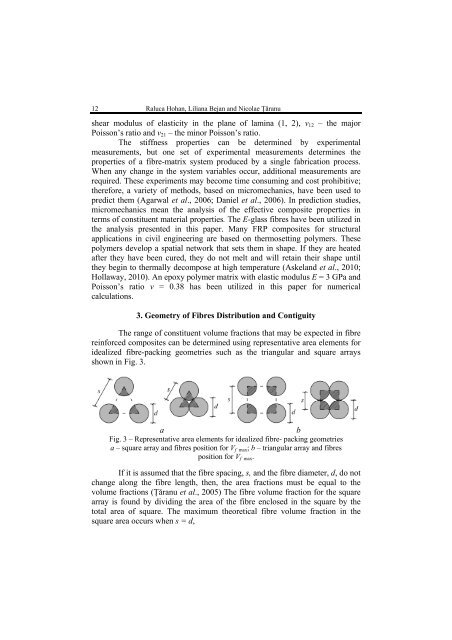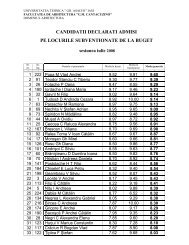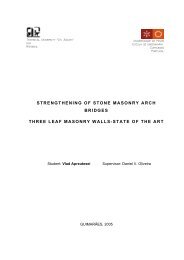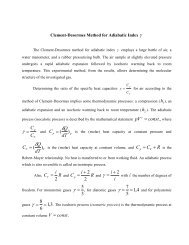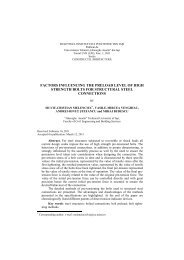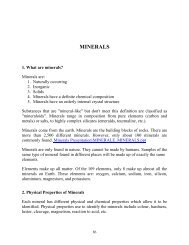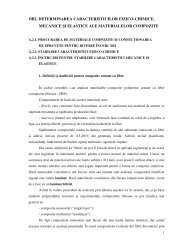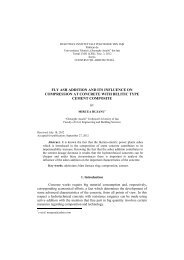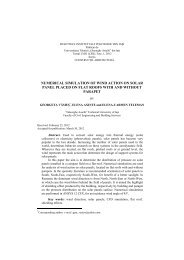effect of contiguity on shear elastic modulus of fibre reinforced ...
effect of contiguity on shear elastic modulus of fibre reinforced ...
effect of contiguity on shear elastic modulus of fibre reinforced ...
Create successful ePaper yourself
Turn your PDF publications into a flip-book with our unique Google optimized e-Paper software.
12 Raluca Hohan, Liliana Bejan and Nicolae Ţăranu<br />
<strong>shear</strong> <strong>modulus</strong> <str<strong>on</strong>g>of</str<strong>on</strong>g> <strong>elastic</strong>ity in the plane <str<strong>on</strong>g>of</str<strong>on</strong>g> lamina (1, 2), ν12 – the major<br />
Poiss<strong>on</strong>’s ratio and ν21 – the minor Poiss<strong>on</strong>’s ratio.<br />
The stiffness properties can be determined by experimental<br />
measurements, but <strong>on</strong>e set <str<strong>on</strong>g>of</str<strong>on</strong>g> experimental measurements determines the<br />
properties <str<strong>on</strong>g>of</str<strong>on</strong>g> a <strong>fibre</strong>-matrix system produced by a single fabricati<strong>on</strong> process.<br />
When any change in the system variables occur, additi<strong>on</strong>al measurements are<br />
required. These experiments may become time c<strong>on</strong>suming and cost prohibitive;<br />
therefore, a variety <str<strong>on</strong>g>of</str<strong>on</strong>g> methods, based <strong>on</strong> micromechanics, have been used to<br />
predict them (Agarwal et al., 2006; Daniel et al., 2006). In predicti<strong>on</strong> studies,<br />
micromechanics mean the analysis <str<strong>on</strong>g>of</str<strong>on</strong>g> the <str<strong>on</strong>g>effect</str<strong>on</strong>g>ive composite properties in<br />
terms <str<strong>on</strong>g>of</str<strong>on</strong>g> c<strong>on</strong>stituent material properties. The E-glass <strong>fibre</strong>s have been utilized in<br />
the analysis presented in this paper. Many FRP composites for structural<br />
applicati<strong>on</strong>s in civil engineering are based <strong>on</strong> thermosetting polymers. These<br />
polymers develop a spatial network that sets them in shape. If they are heated<br />
after they have been cured, they do not melt and will retain their shape until<br />
they begin to thermally decompose at high temperature (Askeland et al., 2010;<br />
Hollaway, 2010). An epoxy polymer matrix with <strong>elastic</strong> <strong>modulus</strong> E = 3 GPa and<br />
Poiss<strong>on</strong>’s ratio ν = 0.38 has been utilized in this paper for numerical<br />
calculati<strong>on</strong>s.<br />
3. Geometry <str<strong>on</strong>g>of</str<strong>on</strong>g> Fibres Distributi<strong>on</strong> and C<strong>on</strong>tiguity<br />
The range <str<strong>on</strong>g>of</str<strong>on</strong>g> c<strong>on</strong>stituent volume fracti<strong>on</strong>s that may be expected in <strong>fibre</strong><br />
<strong>reinforced</strong> composites can be determined using representative area elements for<br />
idealized <strong>fibre</strong>-packing geometries such as the triangular and square arrays<br />
shown in Fig. 3.<br />
a b<br />
Fig. 3 – Representative area elements for idealized <strong>fibre</strong>- packing geometries<br />
a – square array and <strong>fibre</strong>s positi<strong>on</strong> for Vf max; b – triangular array and <strong>fibre</strong>s<br />
positi<strong>on</strong> for Vf max.<br />
If it is assumed that the <strong>fibre</strong> spacing, s, and the <strong>fibre</strong> diameter, d, do not<br />
change al<strong>on</strong>g the <strong>fibre</strong> length, then, the area fracti<strong>on</strong>s must be equal to the<br />
volume fracti<strong>on</strong>s (Ţăranu et al., 2005) The <strong>fibre</strong> volume fracti<strong>on</strong> for the square<br />
array is found by dividing the area <str<strong>on</strong>g>of</str<strong>on</strong>g> the <strong>fibre</strong> enclosed in the square by the<br />
total area <str<strong>on</strong>g>of</str<strong>on</strong>g> square. The maximum theoretical <strong>fibre</strong> volume fracti<strong>on</strong> in the<br />
square area occurs when s = d,


